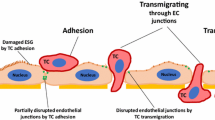Abstract
Purpose. The purpose of the study was to develop a cell culture system representing a layer of cells in a solid tumor, and to use the system to study factors affecting the diffusion of a binding monoclonal antibody.
Methods. A mouse melanoma cell line, B16F10, was grown on Matrigel® coated Transwell® inserts. The diffusion of a binding monoclonal antibody which recognizes the murine transferrin receptor (a-TfR) was investigated, and compared to that of an isotype-matched, nonbinding control.
Results. At a cell density of 6.4 ×105 cells/cm2, 37°C and a donor antibody concentration of 10 nM, the permeability of the a-TfR antibody was approximately half that of the control. Blocking experiments, in which the cell layer was pretreated with excess a-TfR, resulted in equal permeabilities for a-TfR and control antibodies, suggesting that the difference in permeabilities observed in the absence of blocking is due to a-TfR binding. Experiments at 4°C and in the presence of metabolic inhibitors also equalized the permeation rates of the two antibodies, indicating that internalization of the antibody/antigen complex is important in retarding the permeation of the binding antibody.
Conclusions. In this system, the diffusion of the a-TfR antibody is retarded by binding and internalization processes. The results have implications for the use of immunoconjugates in cancer chemotherapy, and for the delivery of other binding macromolecules to tissue sites of action.
Similar content being viewed by others
REFERENCES
D. M. Goldenberg, Monoclonal antibodies in cancer detection and therapy, Am. J. Med., 94:297–312 (1993).
G. A. Peitersz and I. F. C. McKenzie, Antibody conjugates for the treatment of cancer, Immunol. Rev., 129:57–80 (1992).
W. C. Shen, S. Persiani, B. Ballou and T. R. Hakala, Antibodies as drug carriers for solid tumors: evaluation of drug-anti-SSEA-1 conjugates in the treatment of teratocarcinoma. In Targeted Therapeutic Systems, P. Tyle and B. P. Ram (Eds.), Marcel Dekker, Inc., New York, 1990, pp. 289–304.
R. Pirker, Immunotoxins against solid tumors. J. Cancer Res. Clinical Oncol., 114:385–393 (1988).
R. K. Jain, Transport of molecules in the tumor interstitium: a review, Cancer Res., 47:3039–3051 (1987).
R. K. Jain, Transport of molecules across tumor vasculature, Cancer Metastasis Rev., 6:559–593 (1987).
L. M. Cobb, Intratumour factors influencing the access of antibody to tumour cells, Cancer Immunol. Immunother., 28:235–240 (1989).
R. K. Jain, Barriers to drug delivery in solid tumors, Sci. Am., 271:58–65 (1994).
K. Fujimori, D. G. Covell, J. E. Fletcher and J. N. Weinstein, A modeling analysis of monoclonal antibody percolation through tumors: a binding-site barrier, J. Nuclear Med., 31:1191–1198 (1990).
M. Juweid, R. Neumann, C. Paik, M. J. Perez-Bacete, J. Sato, W. van Osdol and J. N. Weinstein, Micropharmacology of monoclonal antibodies in solid tumors: direct experimental evidence for a binding site barrier, Cancer Res., 52:5144–5153 (1992).
K. Lin, J. A. Nagy, H. Xu, T. R. Shockley, M. L. Yarmush and H. F. Dvorak, Compartmental distribution of tumor-specific monoclonal antibodies in human melanoma xenografts, Cancer Res., 54:2269–2277 (1994).
C. Sung, R. L. Dedrick, W. A. Hall, P. A. Johnson and R. J. Youle, The spatial distribution of immunotoxins in solid tumors: assessment by quantitative autoradiography, Cancer Res., 53:2092–2099 (1993).
E. A. Swabb, J. Wei and P. M. Gullino, Diffusion and convection in normal and neoplastic tissues. Cancer Res., 34:2814–2822 (1974).
R. M. Sutherland, Cell and environment interactions in tumor microregions: the multicell spheroid model. Science, 240:177–184 (1988).
M. A. Clauss and R. K. Jain, Interstitial transport of rabbit and sheep antibodies in normal and neoplastic tissues. Cancer Res., 50:3487–3492 (1990).
T. R. Shockley and M. L. Yarmush, Growth of tumor cells within microporous hollow fibers: as in vitro model system for studies of immunoprotein transport, Biotechnol. Bioeng., 35:843–849 (1990).
L. T. Baxter and R. K. Jain, Transport of fluid and macromolecules in tumors. III. Role of binding and metabolism. Microvascular Res., 41:5–23 (1991).
K. Fujimori, D. R. Fisher and J. N. Weinstein, Integrated microscopic-macroscopic pharmacology of monoclonal antibody radioconjugates: the radiation dose distribution. Cancer Res., 51:4821–4827 (1991).
J. A. Hanover and R. B. Dickson, Transferrin: receptor-mediated endocytosis and iron delivery, in Endocytosis, I. Pastan and M. C. Willingham (Eds.), Plenum Press, 1985, pp. 131–161.
G. L. Nicolson, T. Inoue, C. S. Van Pelt and P. G. Cavanaugh, Differential expression of a Mr 90,000 cell surface transferrin receptor-related glycoprotein on murine B16 metastatic melanoma sublines selected for enhanced brain or ovary colonization, Cancer Res., 50:515–520 (1990).
E. L. Cussler, Diffusion: Mass Transfer in Fluid Systems. Cambridge University Press, New York, 1984, pp. 21–32.
M. Brinkley, A brief survey of methods for preparing protein conjugates with dyes, haptens and cross-linking reagents. Bioconjug. Chem., 3:2–13 (1992).
A. Ciechanover, A. L. Schwartz, A. Dautry-Varsat and H. F. Lodish, Kinetics of internalization of recycling of transferrin and the transferrin receptor in a human hepatoma cell line, J. Biol. Chem., 258:9681–9689 (1983).
C. Sung, R. J. Youle, R. L. Dedrick, Pharmacokinetic analysis of immunotoxin uptake in solid tumors: role of plasma kinetics, capillary permeability and binding, Cancer Res., 50:7382–7392 (1990).
Crank, J., The Mathematics of Diffusion, 2nd ed. Oxford University Press, New York, 1975, pp. 49–53.
C. S. Kwok, S. E. Cole and S. K. Liao, Uptake kinetics of monoclonal antibodies by human malignant melanoma spheroids, Cancer Res., 48:1856–1863 (1988).
Rights and permissions
About this article
Cite this article
Vijaykumar, V., Topp, E.M. Diffusion of an Anti-Transferrin Receptor Antibody in Cultured Murine Melanoma Cell Layers. Pharm Res 12, 1907–1916 (1995). https://doi.org/10.1023/A:1016424321378
Issue Date:
DOI: https://doi.org/10.1023/A:1016424321378




